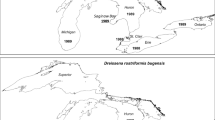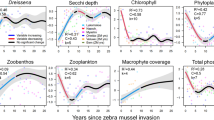Abstract
Although the ecological and economic effects of non-native species probably often change through time, few studies have documented such effects. The zebra mussel (Dreissena polymorpha) is an important invader that has had large ecological and economic effects on the ecosystems it has invaded in North America and western Europe. Our 20-year study of the Hudson River, New York, showed that the characteristics of a zebra mussel population and its effects on other benthic animals both changed substantially through time. Over the period of study, annual survivorship of adult zebra mussels fell >100-fold, which caused the aggregate filtration rate of the population to fall by 82%. Population size and body size of zebra mussels may also have fallen. In the early years of the invasion, densities of nearly all benthic animals in deepwater sites fell steeply (by 80–99%). After about 8 years of decline, these populations began to recover, and are approaching pre-invasion densities. The littoral zoobenthos showed neither the initial decline nor the subsequent recovery. Although the mechanisms behind these changes are not fully clear, our study shows that the effects of an invader may change considerably over time.




Similar content being viewed by others
References
Bastviken DTE, Caraco NF, Cole JJ (1998) Experimental measurements of zebra mussel (Dreissena polymorpha) impacts on phytoplankton community composition. Freshw Biol 39:375–386
Burlakova LE, Karatayev AY, Padilla DK (2006) Changes in the distribution and abundance of Dreissena polymorpha within lakes through time. Hydrobiologia 571:133–146
Caraco NF, Cole JJ, Findlay SEG, Fischer DT, Lampman GG, Pace ML, Strayer DL (2000) Dissolved oxygen declines in the Hudson River associated with the invasion of the zebra mussel (Dreissena polymorpha). Environ Sci Technol 34:1204–1210
Carlsson NOL, Strayer DL (2009) Intraspecific variation in the consumption of exotic prey—a mechanism that increases biotic resistance against invasive species? Freshw Biol 54:2315–2319
Carlsson NOL, Sarnelle O, Strayer DL (2009) Native predators and exotic prey—an acquired taste? Front Ecol Environ 7:525–532
Carlsson NOL, Bustamante H, Strayer DL, Malcom HM (2010) Biotic resistance on the move: native blue crabs structure invasive zebra mussel populations (in preparation)
Cole JJ, Caraco NF (2006) Primary production and its regulation in the tidal-freshwater Hudson River. In: Levinton JS, Waldman JR (eds) The Hudson River estuary. Cambridge University Press, New York, pp 107–120
Connelly NA, O’Neill CR, Knuth BA, Brown TL (2007) Economic impacts of zebra mussels on drinking water treatment and electric power generation facilities. Environ Manage 40:105–112
Davis MA (2009) Invasion biology. Oxford University Press, New York
Du J (2002) Combined algorithms for constrained estimation of finite mixture distributions with grouped data and conditional data. MS thesis, Department of Statistics, McMaster University, Hamilton, Ontario
Fernald SH, Caraco NF, Cole JJ (2007) Changes in cyanobacterial dominance following invasion of the zebra mussel Dreissena polymorpha: long-term results from the Hudson River estuary. Estuaries Coasts 30:163–170
Goedkoop W, Johnson RW (1996) Pelagic–benthic coupling: profundal benthic community response to spring diatom deposition in mesotrophic Lake Erken. Limnol Oceanogr 41:636–647
Hawkes CV (2007) Are invaders moving targets? The generality and persistence of advantages in size, reproduction, and enemy release in invasive plant species with time since introduction. Am Nat 170:832–843
Haynes JM, Tisch NA, Mayer CM, Rhyne RS (2005) Benthic macroinvertebrate communities in southwestern Lake Ontario following invasion of Dreissena and Echinogammarus: 1983–2000. J North Am Benthol Soc 24:148–167
Johnson RK, Wiederholm T (1992) Pelagic-benthic coupling—the importance of diatom interannual variability for population oscillations of Monoporeia affinis. Limnol Oceanogr 37:1596–1607
Kryger J, Riisgard HU (1988) Filtration rate capacities in 6 species of European freshwater bivalves. Oecologia 77:34–38
Llanso R, Southerland M, Vølstad J, Strebel D, Mercurio G, Barbour M, Gerritsen J (2003) Hudson River estuary biocriteria final report. Report to the New York State Department of Environmental Conservation, Albany. 110 pages + appendices. Available at http://nysl.nysed.gov/Archimages/90611.PDF
Lockwood JL, Hoopes MF, Marchetti MP (2007) Invasion ecology. Blackwell, Malden
McCune B, Grace JB (2002) Analysis of ecological communities. MjM Software Design, Gleneden Beach, Oregon
Nalepa TF, Fanslow DL, Lansing MB, Lang GA (2003) Trends in the benthic macroinvertebrate community of Saginaw Bay, Lake Huron, 1987–1996: responses to phosphorus abatement and the zebra mussel, Dreissena polymorpha. J Gt Lakes Res 29:14–33
Nalepa TF, Fanslow DL, Pothoven SA, Foley AJ, Lang GA (2007) Long-term trends in benthic macroinvertebrate populations in Lake Huron over the past four decades. J Gt Lakes Res 33:421–436
Nalepa TF, Fanslow DL, Lang GA (2009) Transformation of the offshore benthic community in Lake Michigan: recent shift from the native amphipod Diporeia spp. to the invasive mussel Dreissena rostriformis bugensis. Freshw Biol 54:466–479
Nieder WC, Barnaba E, Findlay SEG, Hoskins S, Holochuck N, Blair EA (2004) Distribution and abundance of submerged aquatic vegetation in the Hudson River Estuary. J Coast Res 45:150–161
Pace ML, Strayer DL, Fischer DT, Malcom HM (2010) Recovery of native zooplankton associated with increased mortality of an invasive mussel. Ecosphere 1(1):art3. doi:10.1890/ES10-00002.1
Roditi HA, Strayer DL, Findlay SEG (1997) Characteristics of zebra mussel (Dreissena polymorpha) biodeposits in a tidal freshwater estuary. Arch Hydrobiol 140:207–219
Simpson KW, Fagnani JP, Bode RW, DeNicola DM, Abele LE (1986) Organism–substrate relationships in the main channel of the lower Hudson River. J North Am Benthol Soc 5:41–57
Strayer DL (2009) Twenty years of zebra mussels: lessons from the mollusk that made headlines. Front Ecol Environ 7:135–141
Strayer DL, Malcom HM (2006) Long-term demography of a zebra mussel (Dreissena polymorpha) population. Freshw Biol 51:117–130
Strayer DL, Malcom HM (2007) Effects of zebra mussels (Dreissena polymorpha) on native bivalves: the beginning of the end or the end of the beginning? J North Am Benthol Soc 26:111–122
Strayer DL, Smith LC (1996) Relationships between zebra mussels (Dreissena polymorpha) and unionid clams during the early stages of the zebra mussel invasion of the Hudson River. Freshw Biol 36:771–779
Strayer DL, Smith LC (2001) The zoobenthos of the freshwater tidal Hudson River and its response to the zebra mussel (Dreissena polymorpha) invasion. Arch Hydrobiol Suppl 139:1–52
Strayer DL, Powell J, Ambrose P, Smith LC, Pace ML, Fischer DT (1996) Arrival, spread, and early dynamics of a zebra mussel (Dreissena polymorpha) population in the Hudson River estuary. Can J Fish Aquat Sci 53:1143–1149
Strayer DL, Smith LC, Hunter DC (1998) Effects of the zebra mussel (Dreissena polymorpha) invasion on the macrobenthos of the freshwater tidal Hudson River. Can J Zool 76:419–425
Strayer DL, Hattala K, Kahnle A (2004) Effects of an invasive bivalve (Dreissena polymorpha) on fish populations in the Hudson River estuary. Can J Fish Aquat Sci 61:924–941
Strayer DL, Eviner VT, Jeschke JM, Pace ML (2006) Understanding the long-term effects of species invasions. Trends Ecol Evol 21:645–651
Strayer DL, Pace ML, Caraco NF, Cole JJ, Findlay SEG (2008) Hydrology and grazing jointly control a large-river food web. Ecology 89:12–18
Ward JM, Ricciardi A (2007) Impacts of Dreissena invasions on benthic macroinvertebrate communities: a meta-analysis. Divers Distrib 13:155–165
Zippin C (1958) The removal method of population estimation. J Wildl Manage 22:82–90
Acknowledgments
We thank Lane Smith and many Project Assistants for collecting and sorting benthic samples, and Joel Trexler and three reviewers for helpful comments. Funding was provided by the National Science Foundation (DEB 9508981, 0075265, 0454001) and the Hudson River Foundation.
Author information
Authors and Affiliations
Corresponding author
Additional information
Communicated by Joel Trexler.
Rights and permissions
About this article
Cite this article
Strayer, D.L., Cid, N. & Malcom, H.M. Long-term changes in a population of an invasive bivalve and its effects. Oecologia 165, 1063–1072 (2011). https://doi.org/10.1007/s00442-010-1792-0
Received:
Accepted:
Published:
Issue Date:
DOI: https://doi.org/10.1007/s00442-010-1792-0




